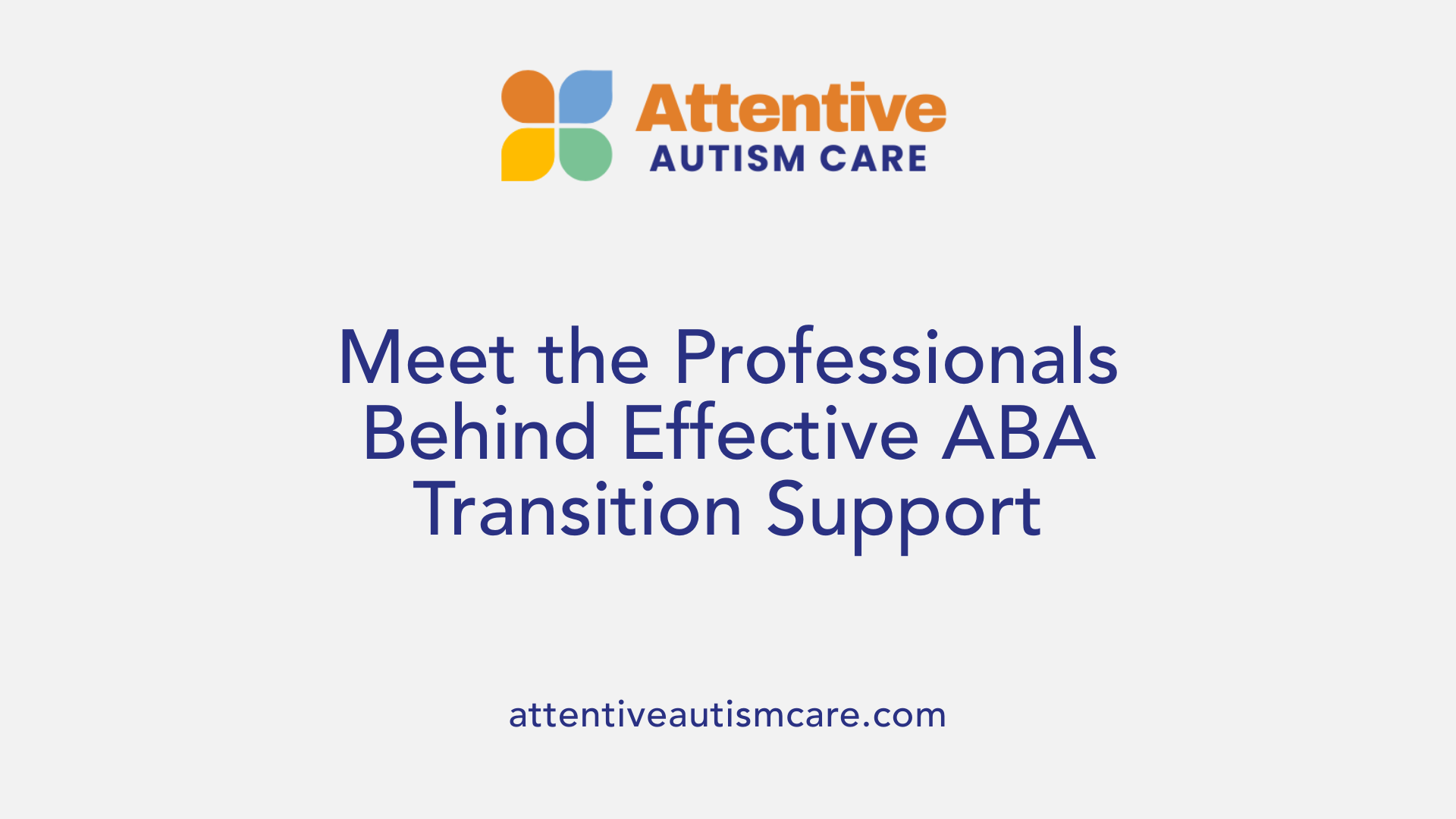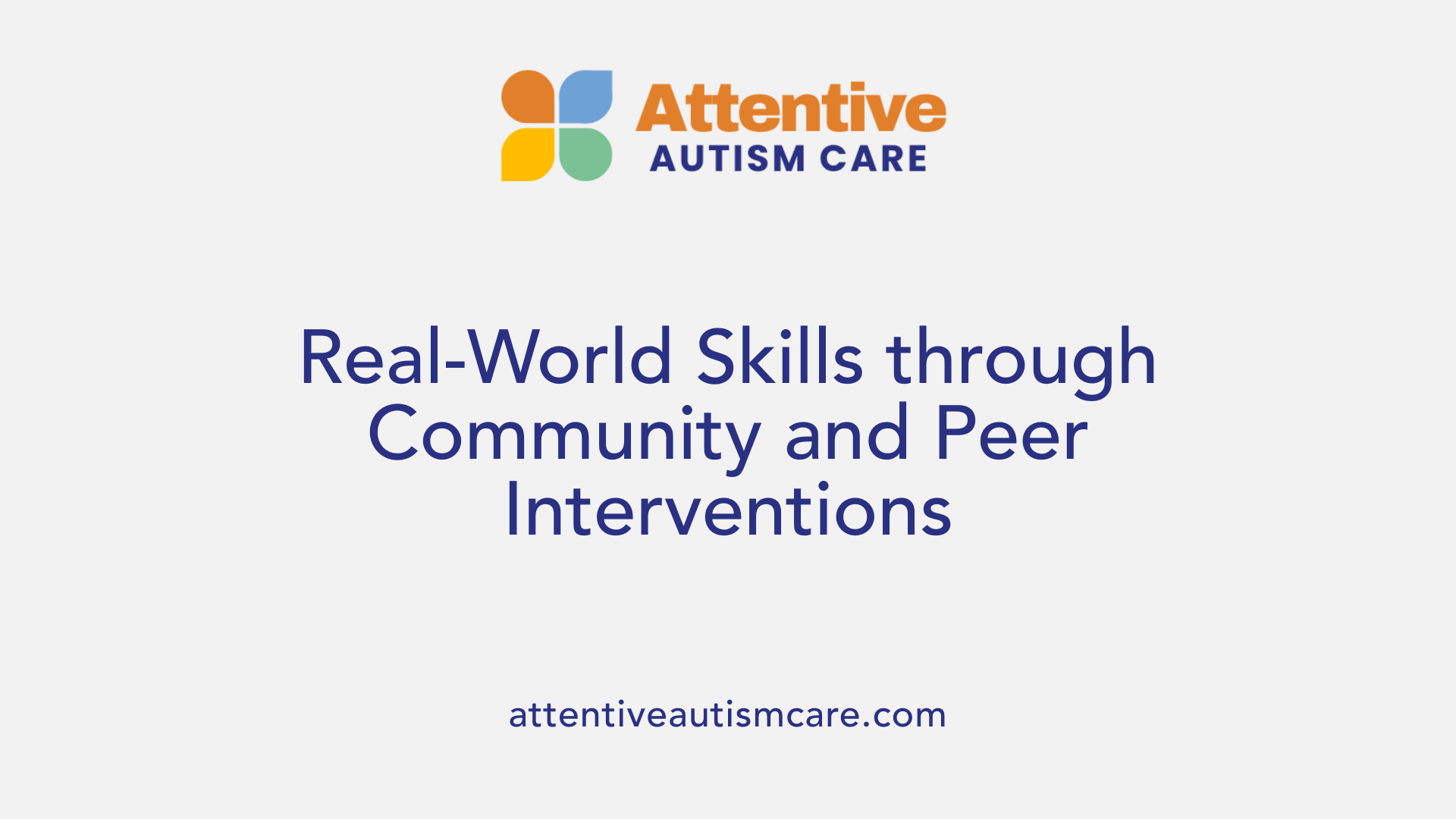Best Practices for Autism Transition Planning
Navigating Effective Strategies for Autism Transition Planning

Understanding the Role of ABA in Autism Transition Planning
Applied Behavior Analysis (ABA) therapy stands as a cornerstone in autism intervention, offering evidence-based methods to support individuals across their development. As children with autism mature, transition planning becomes crucial to prepare them for greater independence and societal participation. This article explores best practices in autism transition planning through the lens of ABA, highlighting key principles, professional expertise, and strategies to optimize outcomes during critical life stages.
Defining Applied Behavior Analysis (ABA) and Its Role in Autism Treatment
What is Applied Behavior Analysis (ABA) therapy and how is it used in treating autism?
Applied Behavior Analysis (ABA) is a well-established scientific discipline focused on analyzing, designing, implementing, and evaluating environmental modifications to produce meaningful behavior change in humans. It uses principles of learning and behavior, such as the Antecedent-Behavior-Consequence (A-B-C) model, to understand how behavior is influenced by the environment and to develop targeted strategies.
ABA is widely recognized as the leading evidence-based treatment for Autism Spectrum Disorder (ASD). Authorities such as the American Academy of Pediatrics and the National Institute of Mental Health endorse ABA as the standard of care for individuals with autism. ABA therapy is designed to improve socially significant behaviors including communication, social skills, autonomy, and reducing challenging behaviors that hinder daily functioning.
Overview of ABA therapy
ABA therapy entails comprehensive and outcome-oriented treatment plans. These plans target specific baseline behaviors with measurable goals and include active caregiver involvement in training and implementation. Treatment is delivered across multiple settings—home, school, community—to ensure skill generalization and maintenance. Interventions can be individual, group-based, or peer-mediated, adapting to diverse learning environments.
Scientific basis of ABA
ABA relies on scientifically validated methods, supported by functional behavior assessments and continuous data collection to monitor progress. Treatment fidelity and regular supervision by qualified professionals such as Board Certified Behavior Analysts (BCBAs) are essential for effectiveness. Systematic reviews and meta-analyses provide strong clinical evidence showing medium to large positive effects of ABA-based interventions, especially when initiated early and delivered intensively.
Use of ABA in autism treatment
Focus areas in autism treatment include addressing core deficits like social communication impairments, language delays, and restricted, repetitive behaviors. Intensive Behavioral Therapy (IBT), derived from ABA principles, typically involves low child-to-therapist ratios and is delivered in naturalistic settings alongside parental training. Strategies such as discrete trial teaching, functional communication training, and naturalistic interventions are commonly employed.
Key goals of ABA programs
The primary goals center around enhancing independence, daily living skills, social participation, and reducing maladaptive behaviors. Transition and discharge planning are integral to ABA therapy, ensuring individuals move towards meaningful life skills with ongoing collaboration among service providers. Documentation and measurable treatment objectives support continuous assessment and adjustment of interventions.
ABA's robust, data-driven framework and its comprehensive approach make it a vital and effective therapy for improving outcomes in individuals with autism.
Key Principles and Techniques in ABA Therapy Relevant to Transition Planning
What are the key principles or techniques used in ABA therapy?
Applied Behavior Analysis (ABA) employs a variety of scientifically validated principles and techniques designed to promote meaningful behavior change, especially in individuals with autism spectrum disorder (ASD).
One primary principle is positive reinforcement, which involves rewarding desired behaviors to increase their occurrence. Therapists use this to build communication, social skills, and independence.
Prompting and fading guide individuals through new tasks by providing assistance initially and gradually removing it as skills become independent. This process ensures learners master each step without becoming reliant on prompts.
Modeling and chaining are also frequently used. Modeling demonstrates desired behaviors for learners to imitate, while chaining breaks complex behaviors into smaller, teachable steps linked together to form a complete skill.
Among key techniques is Discrete Trial Training (DTT), which delivers structured, repetitive teaching trials targeting specific skills. Each trial consists of a clear instruction, learner response, and consequence, promoting efficient skill acquisition.
Visual aids like the Picture Exchange Communication System (PECS) and video modeling provide tangible, easy-to-understand cues supporting communication and social learning. These tools are especially helpful for individuals who benefit from visual input.
Finally, data collection and progress monitoring are fundamental throughout ABA therapy. Therapists continuously measure behaviors and outcomes to evaluate effectiveness, adjust interventions, and set measurable goals. This empirical approach ensures treatment remains individualized and outcome-oriented.
Together, these principles and techniques form the foundation for comprehensive ABA programs, supporting effective transition planning by fostering autonomy, communication, and social functioning across various life settings.
Who Provides ABA Therapy? Qualifications and Roles in Transition Planning

Who provides ABA therapy and what qualifications do these professionals typically have?
ABA therapy is delivered by a range of trained professionals including Board Certified Behavior Analysts (BCBAs), Board Certified Assistant Behavior Analysts (BCaBAs), licensed behavior therapists, and trained behavioral aides.
Professional Qualifications and Certification
To become a BCBA, candidates usually must earn a master's degree in applied behavior analysis, psychology, or a related field. They also complete specialized coursework and accumulate approximately 1,500 to 2,000 hours of supervised practical experience. Certification requires passing an exam administered by the Behavior Analyst Certification Board (BACB).
For BCaBAs and behavior therapists, a bachelor's degree related to psychology or education is common, along with training and supervised experience tailored to their practice level. Behavioral aides typically receive on-the-job training under supervision.
Ethical Standards and Continuing Education
All ABA professionals are bound by ethical standards emphasizing client confidentiality, informed consent, and professional competence. Maintaining certification requires ongoing education to keep skills current and uphold quality of care.
Roles in Supervision and Transition Planning
BCBAs play a vital role in supervising therapy teams, ensuring interventions are implemented correctly, and adapting programs based on data. They lead transition and discharge planning, coordinating with families and other service providers to support clients’ independence and life skills development.
| Professional Role | Education & Training | Responsibilities in ABA |
|---|---|---|
| BCBA | Master's degree + supervised hours | Design, supervise, and adjust treatment plans; lead transition planning |
| BCaBA | Bachelor's degree + supervised hours | Assist in implementing treatment; support BCBA |
| Behavior Therapist/Aide | Varies; training under supervision | Deliver direct therapy; collect data under guidance |
Understanding these qualifications and roles helps ensure ABA therapy services are delivered effectively, safely, and ethically, supporting meaningful outcomes for individuals with autism and related conditions.
Addressing Key Behavioral and Developmental Challenges with ABA
What types of behavioral issues or skills can ABA therapy address?
ABA therapy targets a broad spectrum of behavioral and developmental challenges, with effectiveness demonstrated particularly in individuals with Autism Spectrum Disorder (ASD). One primary focus is on improving communication difficulties through interventions such as functional communication training and picture exchange communication systems (PECS). These methods promote more effective expression of needs and desires.
ABA also enhances social interaction skills. Techniques like peer-mediated instruction and social skills training help individuals engage more successfully with others, fostering important social connections.
In terms of self-care and daily living skills, ABA facilitates autonomy by breaking down tasks into manageable steps using task analysis and naturalistic interventions. This helps individuals acquire and maintain essential daily routines.
Additionally, ABA is effective at reducing aggressive and self-injurious behaviors via functional behavior assessments and differential reinforcement. By understanding environmental triggers and reinforcing positive alternatives, challenging behaviors can be significantly decreased.
Lastly, ABA improves play, attention, and memory abilities using strategies such as modeling, video modeling, scripting, and visual supports. These interventions strengthen cognitive and motor skills necessary for learning and leisure.
Overall, ABA therapy combines evidence-based practices to enhance communication, socialization, independence, and safety, ultimately improving quality of life. It relies on systematic data collection and individualized treatment plans to ensure progress across these domains and to tailor interventions to each person's unique needs.
Evidence Supporting the Effectiveness of ABA in Autism Treatment and Transition
How effective is ABA therapy for individuals on the autism spectrum?
ABA therapy is widely regarded as a highly effective treatment for Autism Spectrum Disorder (ASD). Scientific research, including multiple systematic reviews and meta-analyses, consistently demonstrates that early and intensive ABA interventions can yield substantial improvements in IQ, language abilities, adaptive skills, and reduction in maladaptive behaviors.
What outcomes are observed in IQ, language, and adaptive skills?
Children receiving ABA-based therapies, such as Early Intensive Behavioral Intervention (EIBI), often show medium to large gains in critical developmental areas. Improvements typically include enhanced communication skills, increased social interaction, better emotional regulation, and more adaptive functioning in daily life. These positive outcomes help individuals engage more fully at home, school, and community settings.
Why is early and intensive intervention important?
Providing ABA therapy at an early age, ideally before 12 years old, and delivering it with appropriate intensity (often multiple hours per week) greatly influences the effectiveness of treatment. Early intervention addresses core ASD features promptly, helping to shape foundational skills before maladaptive behaviors can become deeply ingrained.
What role do parental training and implementation fidelity play?
Parental involvement is crucial in ABA programs, as caregiver training facilitates consistent implementation and reinforcement across environments. Furthermore, maintaining high fidelity is essential; using fidelity checklists and supervision ensures interventions are applied as designed, which directly correlates with improved outcomes.
How is ABA recognized by professional bodies?
ABA is acknowledged as the gold standard evidence-based treatment for ASD by authoritative organizations such as the American Academy of Pediatrics and the National Institute of Mental Health. These bodies endorse ABA’s structured, data-driven approach and advocate for its use as a primary intervention strategy.
| Aspect | Description | Impact on Treatment Effectiveness |
|---|---|---|
| Scientific Research | Systematic reviews and meta-analyses confirm ABA’s positive effects across developmental domains | Validates ABA as an evidence-based therapy |
| Early, Intensive Intervention | Early age initiation and sufficient therapy hours improve skill acquisition and reduce behaviors | Maximizes developmental gains |
| Parental Training | Caregiver involvement supports consistent application and generalization in natural settings | Enhances progress and sustainability of gains |
| Implementation Fidelity | Regular monitoring through fidelity checklists ensures protocols are correctly followed | Critical for achieving meaningful behavioral change |
| Professional Recognition | Recommendations by major pediatric and mental health organizations highlight ABA’s importance | Encourages widespread adoption and insurance coverage |
Planning Transitions Using ABA: Framework and Goals
Why is transition and discharge planning important in ABA?
Transition and discharge planning are essential components of ABA therapy, aimed at supporting individuals with Autism Spectrum Disorder (ASD) as they move towards greater independence and life skills. These plans help maintain gains made during therapy and ensure that individuals can generalize skills across settings. Integrating careful planning addresses the eventual shift from intensive behavioral therapy to less intensive supports, facilitating smoother personal development and reducing service gaps.
How are measurable goals set based on baseline data?
Effective transition planning begins with defining clear, measurable goals. Practitioners collect detailed baseline data to identify each individual’s starting point, which guides the setting of realistic and specific objectives. These goals often target autonomy, communication, social skills, and reduction of challenging behaviors. Using data-driven strategies ensures progress is consistently monitored and interventions are adjusted to meet evolving needs.
How are transition goals integrated into IEPs and IFSPs?
Transition goals should be embedded within Individualized Education Programs (IEPs) and Individualized Family Service Plans (IFSPs) to align with educational and developmental priorities. This integration facilitates continuous support within school and community settings. It ensures that educators and therapists share a consistent approach, helping the individual achieve functional outcomes such as improved social communication and independence.
What is the role of collaboration with families and multidisciplinary teams?
Collaborative coordination among families, educators, therapists, and other service providers is vital. Family involvement in training and implementation boosts generalization of skills and enhances therapy effectiveness. Multidisciplinary teamwork ensures that interventions are comprehensive, addressing all aspects of a child’s development. This holistic approach supports seamless transitions and ongoing success across different life stages and environments.
Utilizing Evidence-Based Practices (EBPs) in Transition Planning
What Are Evidence-Based Practices (EBPs) for Autism and Why Are They Important?
Evidence-Based Practices (EBPs) are interventions and strategies that have been scientifically tested and proven effective in improving outcomes for individuals with Autism Spectrum Disorder (ASD). Utilizing EBPs ensures that treatment and education are grounded in reliable research, maximizing positive changes in social, communication, and adaptive behaviors. Particularly during transition planning—when individuals move toward greater independence—using EBPs supports meaningful growth and skill generalization.
The National Professional Development Center’s (NPDC) 27 EBPs
The NPDC on Autism Spectrum Disorder has identified 27 EBPs designed to improve educational and developmental outcomes for students with ASD. These practices cover a diverse range of techniques to address various needs and promote individualized learning and behavior change.
Examples of EBPs Used in Transition Planning
Some commonly implemented EBPs during transition include:
- Functional Behavior Assessment (FBA): A systematic process to identify the causes of challenging behaviors, allowing tailored interventions.
- Social Skills Training: Methods to improve interpersonal communication and interactions, vital for community engagement and independence.
- Video Modeling: Using video clips to demonstrate desired behaviors or skills, helping learners imitate and practice.
These examples target socially significant behaviors essential for successful life transitions.
Implementing EBPs with Fidelity and Monitoring Progress
Applying EBPs effectively requires strict adherence to their protocols, called fidelity. This involves using fidelity checklists, consistent application across settings and personnel, and ongoing supervision. Regular data collection is critical to monitor progress, allowing for instructional adjustments based on measurable outcomes. This rigorous approach ensures that the interventions remain effective and aligned with the individual’s goals.
By integrating EBPs thoughtfully during transition planning, educators and therapists can optimize support and enable individuals with ASD to thrive in new environments and stages of life.
The Role of Functional Behavior Assessment (FBA) in Transition Planning

Conducting FBAs for Identifying Challenging Behaviors
Functional Behavior Assessment (FBA) is a critical tool in ABA for systematically identifying the reasons behind challenging behaviors, particularly in individuals with Autism Spectrum Disorder (ASD). Through direct observation, data collection, and analysis, FBAs help determine the environmental triggers and consequences that maintain problematic behaviors. This assessment enables clinicians to develop precise hypotheses about the function of such behaviors, which is essential for creating effective intervention plans.
Targeting Interventions Based on Functional Analysis
Once the function of a behavior is identified through FBA, targeted interventions can be designed to address the root causes rather than merely managing symptoms. For example, if a behavior serves to escape difficult tasks, interventions can include teaching alternative communication strategies or modifying task demands. This function-based approach increases the likelihood of meaningful behavior change and enhances the individual’s autonomy and social skills.
Incorporating FBA Findings into Transition Goals
In transition planning, FBA findings are integral in setting measurable and individualized goals that promote independence and life skills. The data from the assessment informs which behaviors need to be reduced and what new skills should be acquired to facilitate successful transitions to new environments, such as school, community settings, or adulthood. Integrating FBA results into Individualized Education Programs (IEPs) or Individualized Family Service Plans (IFSPs) ensures that interventions remain relevant and continuously adjusted based on ongoing progress monitoring.
Caregiver and Family Involvement in ABA-Based Transition Plans
Training caregivers for consistent implementation
Caregiver training is a fundamental component of successful ABA therapy, especially during transition phases. Training equips families with the skills needed to implement behavior interventions consistently and accurately across various settings. This consistency reinforces learning and promotes maintenance and generalization of skills, enabling smoother transitions toward independence.
Benefits of family participation
Active family involvement in ABA transition plans leads to better outcomes for individuals with ASD. Families provide essential insights into daily routines and preferences, helping tailor interventions to real-life contexts. Moreover, their engagement fosters a supportive home environment, encourages generalization of skills, and enhances communication between therapy and home life.
Strategies for effective communication and support
Effective transition planning requires clear, ongoing communication between therapists and families. Establishing regular updates through meetings or written reports ensures caregivers stay informed about progress and any adaptations needed. Support networks, including parent training sessions and resource sharing, empower families to confidently participate in the intervention process. Collaborative problem-solving also strengthens relationships and addresses challenges promptly, maximizing intervention success.
Multisetting Delivery of ABA Services to Support Skill Generalization
How Is ABA Provided Across Multiple Settings?
ABA services are most effective when delivered across varied environments including the home, school, and community. This multisetting approach helps individuals with autism spectrum disorder (ASD) apply learned skills in real-life situations, promoting meaningful behavioral change.
In home settings, therapy focuses on individualized instruction and family involvement. Schools provide structured learning environments where children can practice academic and social skills. Community settings offer opportunities to generalize these skills in varied social and public contexts.
Why Is Practicing Skills in Natural Environments Important?
Practicing skills in natural environments ensures that behavior changes are functional and relevant. When ABA strategies are applied beyond therapy rooms, individuals with ASD can adapt to everyday social interactions and challenges. This leads to better maintenance of gains and increases independence.
Natural environments provide realistic contexts where communication, social skills, and daily living tasks can be rehearsed and reinforced. This approach also helps mitigate challenges by addressing them where they occur.
What Role Do Group and Peer-Mediated Interventions Play?
Group-based interventions create opportunities for social interaction and collaboration among peers, fostering social communication and social skills.
Peer-mediated instruction involves training typical peers to support skill development in children with ASD. This method encourages natural social engagement and promotes inclusion within social groups.
Together, individual, group, and peer-mediated interventions offer a comprehensive framework that supports skill acquisition, retention, and generalization across multiple settings.
| Setting | Focus Area | Benefits |
|---|---|---|
| Home | Individualized instruction, family training | Enhances carry-over of skills to daily life |
| School | Academic skills, social interaction | Supports educational goals and peer relationships |
| Community | Social participation, adaptive living | Promotes independence and generalization of skills |
| Group Settings | Social skills development | Encourages cooperative play and natural socialization |
| Peer-Mediated | Social communication | Facilitates inclusive interactions and natural support |
Supervision and Case Support for Effective Transition Implementation
Individualized Oversight for Challenging Behaviors
Supervision in ABA therapy must be tailored to each individual's needs, particularly those exhibiting significant challenging behaviors. This personalized oversight ensures that interventions are effectively addressing behavior changes while maintaining safety and therapeutic integrity.
Role of Board Certified Behavior Analysts (BCBAs) in Supervision
Board Certified Behavior Analysts (BCBAs) play a crucial role in the supervision process. They provide expert guidance and ongoing direct supervision, which involves reviewing data, coaching therapists, and adapting treatment plans to optimize outcomes during all therapy phases, including transitions.
Monitoring Protocol Adherence and Progress
Consistent monitoring of protocol adherence is essential for maintaining treatment fidelity. Supervisors systematically review session notes and behavior tracking data to ensure that interventions are implemented as designed. This oversight allows timely adjustments to improve behavior change and supports the successful transition of clients towards greater independence.
Documentation and Compliance in ABA Transition Planning

Maintaining comprehensive assessment records
Effective ABA transition planning hinges on meticulous documentation practices. Comprehensive assessment records form the foundation of these efforts. They encompass detailed evaluations of baseline behaviors, functional behavior assessments (FBA), and ongoing data that monitor the individual's progress and changing needs. These records ensure that any modifications in behavior or treatment requirements are well understood and addressed promptly.
Detailed treatment plans and session notes
Treatment plans must be outcome-oriented and explicitly outline measurable goals tailored to the individual’s current needs. Documentation of session notes is equally essential — these include data on the implementation of interventions, fidelity checks, behavior changes observed during sessions, and any adjustments made. Precise records facilitate informed decision-making and support fidelity to evidence-based practices.
Care coordination documentation for transitions
Transition and discharge planning require diligent documentation to coordinate with families, educators, and other service providers. This includes records of communication, updates to Individualized Education Plans (IEPs) or Individualized Family Service Plans (IFSPs), and strategies to promote autonomy and life skills. Coordinated documentation supports smooth handoffs between providers and settings, ensuring continuity of care and maximizing treatment outcomes.
Early Intensive Behavioral Intervention (EIBI) as a Foundation for Transition Success
What Are the Benefits of Early Intervention for Developmental Outcomes?
Early intervention, particularly for children with Autism Spectrum Disorder (ASD), can significantly enhance various developmental outcomes. Research shows that beginning treatment early in life, especially before age 12, often results in meaningful gains. These include improvements in IQ, language and communication skills, adaptive behaviors, and reductions in maladaptive behaviors. Such early gains lay a critical foundation for long-term progress and improved quality of life.
How Does EIBI Target Core Symptoms of ASD?
Early Intensive Behavioral Intervention (EIBI) is a structured approach based on Applied Behavior Analysis (ABA) principles. EIBI focuses intensely on core ASD symptoms such as social communication deficits, language delays, and restricted or repetitive behaviors. Techniques used within EIBI include discrete trial teaching, naturalistic interventions, functional behavior assessments, and reinforcement strategies. Treatment occurs in home or community settings with low child-to-therapist ratios, often following individualized plans supervised by credentialed professionals.
What Is the Link Between Early Therapy and Improved Transition Readiness?
Early intervention through EIBI doesn't just improve immediate skills—it also supports smoother transitions to subsequent stages of development. Gains in communication, social skills, and behavior regulation enable children to better participate in educational and social environments. These improvements facilitate easier movement toward independence and life skills, which are focal points in later transition and discharge planning. Effective early therapy typically involves comprehensive planning with measurable goals, family involvement, and continuous data-driven adjustments, all of which contribute to readiness for successful transitions into adolescence and beyond.
Intensive Behavioral Therapy (IBT) Delivery Models for Transition Support
In which settings is IBT typically delivered for autism?
IBT is most effectively delivered in home or community settings. These environments allow for naturalistic learning opportunities and help ensure that skills generalize beyond clinical settings. Delivering therapy in everyday contexts supports meaningful behavior changes that translate into improved daily functioning for individuals with autism.
What is the recommended therapist-to-child ratio in IBT programs?
A low child-to-therapist ratio is essential in IBT to provide individualized attention and ensure effective intervention. This often means one therapist per child or very small groups. Such ratios facilitate tailored instruction and allow therapists to closely monitor progress, adjust treatment plans, and provide immediate feedback.
Who provides direct supervision in IBT services?
Direct supervision is typically provided by qualified professionals such as Board Certified Behavior Analysts (BCBAs), licensed mental health clinicians trained in ABA, or trained paraprofessionals under close oversight. This supervision ensures fidelity to ABA principles and helps maintain high treatment standards, especially when addressing core autism features like communication deficits and repetitive behaviors.
How do these delivery models support transition?
Home and community-based delivery with low therapist-to-child ratios under expert supervision creates an optimal setting to address transition goals. These models enable effective teaching of life skills and social communication within real-world contexts. Continuous supervision promotes regular data collection and treatment plan adjustments, facilitating smoother transitions toward independence.
| IBT Delivery Aspect | Description | Role in Transition Support |
|---|---|---|
| Settings | Home and community-based environments | Supports skill generalization in natural contexts |
| Therapist-to-child Ratio | Low ratio (often 1:1) | Ensures personalized instruction and monitoring |
| Direct Supervision | Provided by BCBAs or qualified clinicians | Maintains intervention fidelity and guides treatment updates |
These elements combined form a structured, evidence-based approach to IBT delivery, promoting positive outcomes during periods of transition for children and adolescents with autism.
Policy and Legal Frameworks Supporting ABA and Transition Planning
What Federal Mandates Require Use of Evidence-Based Practices?
Federal laws such as the Every Student Succeeds Act (ESSA) and the Individuals with Disabilities Education Act (IDEA) 2004 mandate the use of evidence-based practices (EBPs) to support children with autism within educational settings. These mandates ensure that interventions, including Applied Behavior Analysis (ABA), are grounded in scientific research and lead to measurable improvements in educational outcomes.
What Guidelines Do Professional Societies Provide for ABA Treatments?
Professional organizations like the American Academy of Pediatrics and the American Academy of Child and Adolescent Psychiatry endorse ABA as the standard of care for Autism Spectrum Disorder (ASD). Their guidelines emphasize early, intensive, and individualized ABA treatments that include functional assessments, measurable goal-setting, and consistent monitoring. These guidelines also highlight the necessity of involving families in treatment planning and the importance of transitioning services as children grow older.
How Are ABA Services Reimbursed and Coded?
Reimbursement for ABA services involves specific procedural codes such as CPT and HCPCS codes designated for assessments and behavioral interventions. Policies require that ABA services be provided by qualified professionals, including Board Certified Behavior Analysts (BCBAs), licensed mental health clinicians trained in ABA, or supervised paraprofessionals. Treatment plans must document family involvement, address specific behavioral deficits, and include transition strategies, especially for older children and adolescents, to meet compliance and ensure insurance coverage.
By aligning with federal mandates, professional guidelines, and reimbursement policies, ABA programs maintain quality standards while facilitating effective transition planning for individuals with autism.
Measuring and Monitoring Progress During Transition Phases
Why is Data Collection and Baseline Measurement Important?
Accurate data collection at the outset of transition planning is essential in ABA therapy to establish a clear baseline. This starting point helps identify the individual's current capabilities and behaviors, guiding the development of targeted, measurable goals. Without baseline data, it becomes challenging to quantify progress or make informed decisions about therapeutic adjustments.
How Should Interventions Be Adjusted Based on Progress?
Ongoing evaluation of an individual’s response to intervention allows therapists and caregivers to tailor treatment plans dynamically. If data indicate insufficient progress toward goals, modifications can be made, such as changing strategies, increasing intensity, or introducing new evidence-based practices. This flexibility ensures the interventions remain effective and personalized to the individual's evolving needs.
What Role Do Fidelity Checklists Play in Monitoring?
Fidelity checklists are vital tools used to ensure that evidence-based practices are implemented consistently and accurately across different settings and providers. Regular monitoring with these checklists helps maintain treatment integrity, which is strongly linked to positive outcomes. They also assist supervisors in identifying areas where additional training or support may be necessary to uphold high-quality intervention delivery.
Transition and Discharge Planning: Moving Toward Independence
What are the goals of transition and discharge planning in ABA therapy?
Transition and discharge planning in ABA therapy focus on helping individuals with Autism Spectrum Disorder (ASD) acquire life skills and autonomy necessary for increased independence. These plans aim to guide individuals through critical developmental stages by setting clear targets that emphasize daily living skills, social competence, communication, and vocational readiness.
How is coordination with schools, vocational services, and community supports achieved?
Effective transition requires collaboration across multiple settings. ABA programs integrate efforts with schools, vocational agencies, healthcare providers, and community organizations to ensure continuity of care. This multidisciplinary coordination helps maintain skill generalization and supports the individual in diverse environments including educational settings and employment opportunities.
How can adolescents and young adults be prepared for transitions?
Preparation involves gradually introducing new routines, teaching coping strategies for change, and training caregivers to support autonomy. Emphasis is placed on establishing measurable goals within Individualized Education Programs (IEPs) or Individualized Family Service Plans (IFSPs), using evidence-based practices tailored to each individual's needs. Ongoing data monitoring ensures progress and informs adjustments.
Through comprehensive planning that aligns with the individual's strengths and challenges, transition and discharge processes in ABA therapy foster successful adaptation to adulthood and community life, ultimately promoting independence and quality of life.
Challenges and Strategies for Transitioning Older Children and Adolescents
What Are the Complex Challenges Faced by Older Youth in ABA Transitions?
Transitioning older children and adolescents with Autism Spectrum Disorder (ASD) presents unique challenges that differ from those encountered with younger children. As individuals age, their needs become more complex, encompassing not only basic communication and social skills but also academic readiness, vocational skills, and increasing autonomy. This complexity requires careful planning and adjustment in Applied Behavior Analysis (ABA) interventions to support developmental and environmental changes.
Moreover, adolescents often face an increase in challenging behaviors during transitions, stemming from social pressures, heightened awareness of differences, and stressors associated with changing environments. Effective ABA programs must address these behaviors to promote smoother transitions.
How Are Treatment Plans Tailored to Develop Academic, Social, and Vocational Skills?
To meet the varied and evolving needs of older children and adolescents with ASD, ABA treatment plans are tailored to target socially significant behaviors that promote independence and inclusion. These plans are outcome-oriented, featuring measurable goals based on baseline assessments.
Key areas of focus include:
- Academic skills: Enhancing skills related to classroom success and learning engagement.
- Social skills: Developing peer interaction, communication, and adaptive social behavior.
- Vocational skills: Preparing for employment through task analysis, job coaching, and community-based interventions.
Combining individual, group, and community-based settings ensures skills generalize effectively. Caregiver involvement remains essential, facilitating consistent support across environments.
How Does ABA Address Challenging Behaviors During Transitions?
Behavioral challenges can intensify during periods of transition, making focused interventions critical. Applied Behavior Analysis employs functional behavior assessments (FBA) to identify antecedents and consequences that maintain problematic behaviors.
Interventions such as differential reinforcement, functional communication training, and environmental modifications are implemented to reduce challenging behaviors. Continuous monitoring using fidelity checklists and data collection guides adjustments to the treatment plan, ensuring it responds effectively to an adolescent's changing needs.
Transition and discharge planning are integral components of ABA therapy, oriented towards promoting independence and integrating individuals into broader social and vocational roles. Coordination with other service providers and educational systems ensures comprehensive support during these critical stages.
Collaborating Across Disciplines to Enhance Transition Outcomes
Integrating ABA with Speech and Occupational Therapy
Effective transition outcomes for individuals with Autism Spectrum Disorder (ASD) rely on the integration of Applied Behavior Analysis (ABA) with other therapies such as speech and occupational therapy. ABA focuses on socially significant behaviors, while speech therapy targets communication skills and occupational therapy addresses daily living and sensory needs. Coordinated approaches ensure that therapeutic goals complement one another, fostering comprehensive skill development.
Communication Between Providers and Families
Open, consistent communication among treatment providers and families is vital. Families play a crucial role in implementing behavior plans and supporting generalization across settings. Regular updates, training sessions, and collaborative problem-solving help maintain adherence to treatment protocols and address challenges promptly. This partnership empowers caregivers and enhances the continuity of care.
Creating Unified Transition Goals
Transition planning should unify objectives across disciplines to target independence and life skills. Jointly developed goals, routinely updated based on ongoing assessments and data collection, create a cohesive framework for progress. Incorporating measurable targets within Individualized Education Programs (IEPs) or Individualized Family Service Plans (IFSPs) ensures interventions are purposeful and outcomes are regularly evaluated. This synthesis promotes successful transitions from therapy to school, community, or adult services.
Training and Supporting Paraprofessionals in Transition Programs

Roles of Paraprofessionals Under Supervision
Paraprofessionals play a vital role in delivering Applied Behavior Analysis (ABA) services, especially during transition programs for individuals with Autism Spectrum Disorder (ASD). They implement direct interventions under the supervision of qualified professionals such as Board Certified Behavior Analysts (BCBAs) or licensed mental health clinicians with ABA training. Their responsibilities typically include working one-on-one with clients, assisting in generalization of skills across settings, and supporting social, communication, and life skills development critical for successful transitions.
Ensuring Fidelity of Intervention Delivery
Maintaining fidelity in ABA intervention delivery by paraprofessionals is essential for achieving desired outcomes. This is accomplished through regular monitoring using fidelity checklists and consistent adherence to treatment protocols. Supervisors conduct frequent observations and data reviews to verify that paraprofessionals apply evidence-based practices (EBPs) accurately and uniformly. Ensuring fidelity also involves consistency across settings, personnel, and materials to support generalization and maintenance of skills.
Ongoing Training and Supervision
Effective training involves initial comprehensive instruction on intervention techniques and continuous professional development tailored to individual paraprofessional needs. Ongoing supervision includes frequent feedback sessions, case reviews, and problem-solving discussions to address challenges encountered during service delivery. Structured supervision schedules facilitate timely adjustments to treatment plans and reinforce skill acquisition, supporting paraprofessionals in confidently implementing behavioral strategies crucial for smooth transitions toward independence.
Using Visual Supports and Technology to Enhance Transition Success
Picture Exchange Communication System (PECS)
PECS is a widely recognized evidence-based practice designed to support communication for individuals with autism. It enables users to communicate desires and needs through exchanging pictures, making it easier for nonverbal or minimally verbal individuals to express themselves. PECS not only fosters communication skills but also supports smoother transitions by reducing frustration and enhancing independence.
Video Modeling and Prompting
Video modeling is an effective intervention involving watching videos that demonstrate specific skills or behaviors. This method capitalizes on visual learning strengths common among individuals with ASD, allowing them to observe and imitate social interactions or daily living skills. When paired with prompting—carefully timed cues to encourage responses—video modeling becomes a powerful tool to facilitate skill acquisition critical during transitions between settings.
Digital Tools for Skills Acquisition
Technology-based interventions, including apps and software, offer interactive and customizable platforms to teach various skills. These digital tools can provide consistent practice opportunities across different settings, support data collection, and engage users in motivating ways. They often incorporate visual supports such as icons, animations, and step-by-step guides, enhancing comprehension and retention of new skills crucial for successful transitions.
Leveraging PECS, video modeling coupled with prompting, and digital technologies ensures transition planning in autism interventions is comprehensive and effective. When integrated thoughtfully, these tools facilitate greater independence, communication, and adaptability, all of which are essential for meaningful progress during periods of change.
Community-Based Interventions and Peer-Mediated Instruction for Real-World Skills

Social Skills Training in Community Settings
Effective ABA programs emphasize the importance of delivering interventions across multiple settings, including community environments, to promote generalization and maintenance of skills. Community-based social skills training allows individuals with Autism Spectrum Disorder (ASD) to practice essential communication and interaction skills in natural, everyday contexts. This approach encourages autonomy and supports the development of socially significant behaviors such as initiating conversations, understanding social cues, and participating in group activities.
Peer Interactions and Mentoring
Peer-mediated instruction is a widely recognized evidence-based practice within ABA that involves training typically developing peers to interact, support, and model appropriate social behaviors. This method fosters meaningful peer relationships and creates natural opportunities for social engagement. Peers can serve as mentors, facilitating skills like cooperation, turn-taking, and problem-solving, which are critical for social inclusion and community participation.
Facilitating Social Participation
To enhance social participation, ABA interventions aim to reduce challenging behaviors that may hinder engagement and increase communicative abilities. Structured group activities and community outings promote practicing skills in dynamic environments, preparing individuals for independent social interactions. Ongoing data collection and monitoring ensure individualized goals are met and help tailor interventions to meet changing needs. Collaboration with caregivers and service providers helps sustain social involvement, supporting successful transition planning towards more autonomous community integration.
Sustaining Gains: Strategies for Long-Term Skill Maintenance Post-Transition
How does ABA promote the generalization of learned behaviors?
ABA programs are designed to deliver interventions across multiple settings, including individual, group, and community environments. This diversity helps individuals with autism apply skills learned in therapy to real-world situations, facilitating the generalization of behaviors beyond the treatment context. By involving various locations and social settings, ABA ensures that behaviors are functional and useful in daily life.
Why are periodic review and booster sessions important?
Periodic reviews and booster sessions play a crucial role in maintaining and strengthening the skills acquired during intensive behavioral therapy. Regular monitoring helps detect any regression or challenges that may arise, allowing timely adjustments to treatment plans. Booster sessions serve as refreshers to reinforce previously learned skills, thus supporting long-term behavior retention.
How do support networks and ongoing resources assist in sustaining gains?
Family involvement and caregiver training are integral components of ABA therapy, extending support beyond formal sessions. Establishing strong support networks—including caregivers, educators, and community providers—ensures consistent implementation of strategies and promotes independence. Access to ongoing resources, such as behavioral consultants and community programs, provides continuous reinforcement, encouragement, and guidance, fostering a stable environment for sustained success.
Embracing Comprehensive ABA Strategies for Successful Autism Transition
Effective transition planning for individuals with autism requires a thorough application of evidence-based ABA principles, tailored to individual needs and developmental stages. By integrating comprehensive assessments, personalized goal setting, caregiver involvement, and multidisciplinary collaboration, ABA practitioners can facilitate meaningful progress towards independence and community participation. Rigorous supervision, multisetting interventions, and fidelity monitoring ensure quality and consistency in service delivery. Emphasizing early intensive interventions and leveraging technology and peer supports further enhance transition success. Ultimately, a coordinated and data-driven approach transforms transition challenges into opportunities for lifelong growth and fulfillment.
References
- Applied Behavior Analysis (ABA) Supplemental Clinical ...
- Page 2: Evidence-Based Practices - IRIS Center
- INTENSIVE BEHAVIORAL THERAPY (IBT) / APPLIED ...
- A Comprehensive Guide to ABA Therapist Requirements
- How to Become an Applied Behavior Analyst (ABA) Therapist
- How to Become an ABA Therapist - School of Education
- Your Complete Guide to Becoming an ABA Therapist
- Applied Behavior Analysis (ABA)
- Debunking 7 Common Myths About ABA Therapy - GSEP Blog
- Applied Behavior Analysis in Children and Youth with Autism ...



































































































